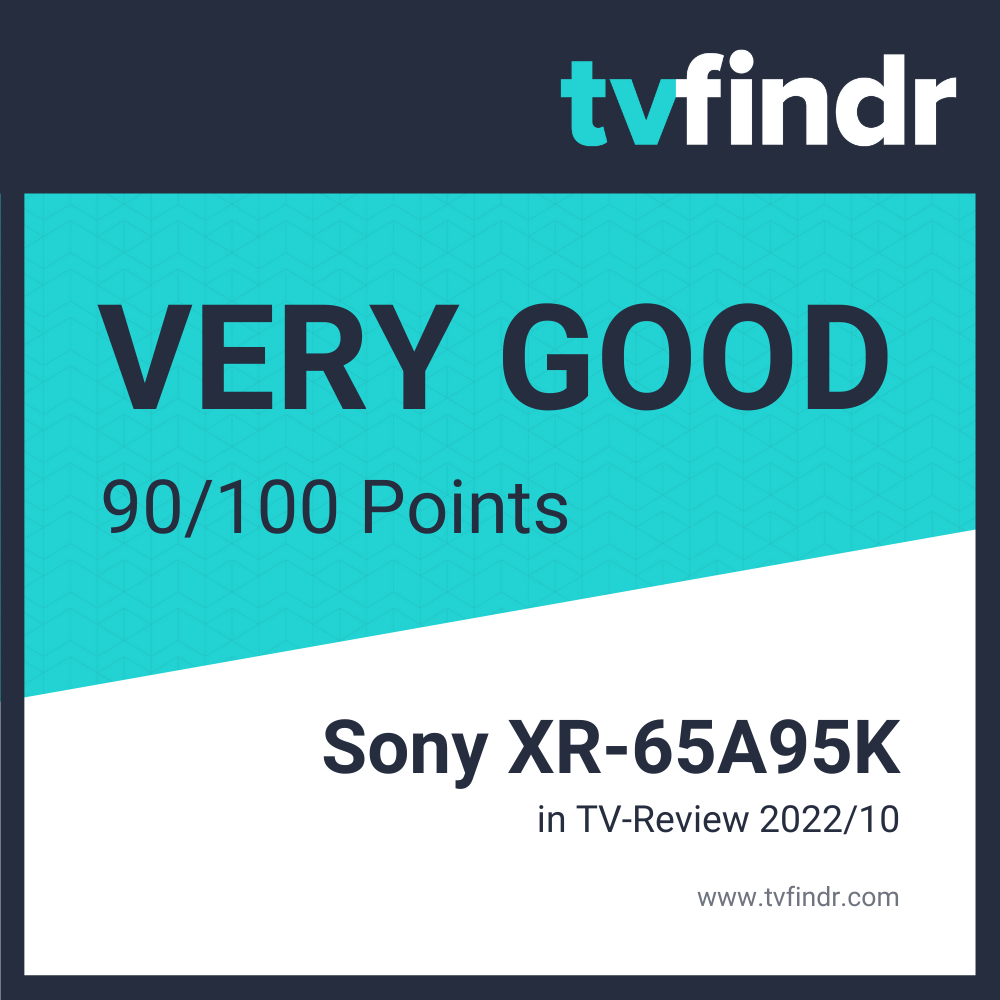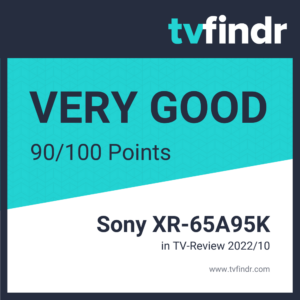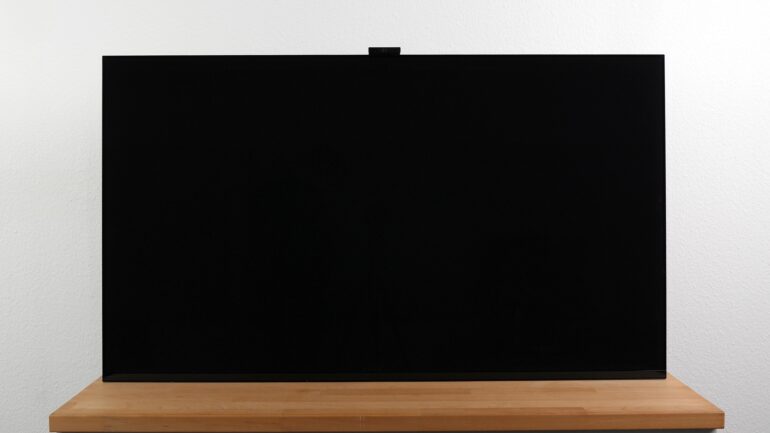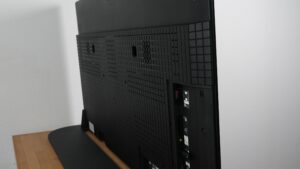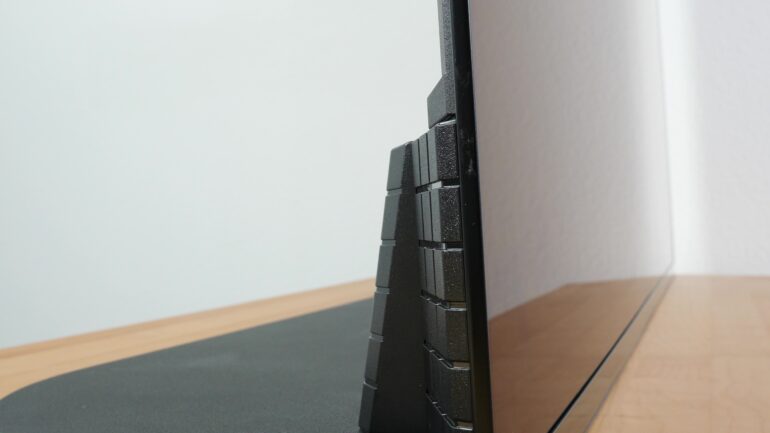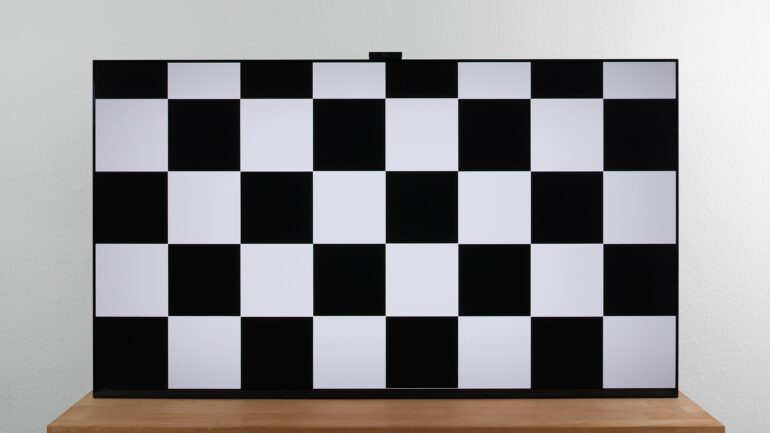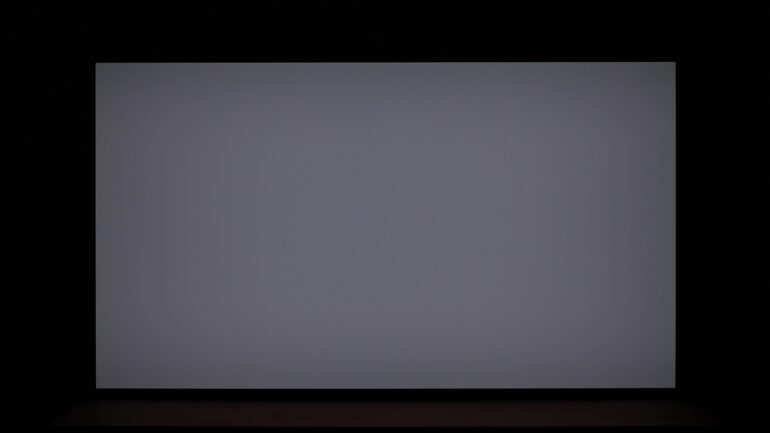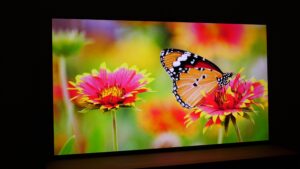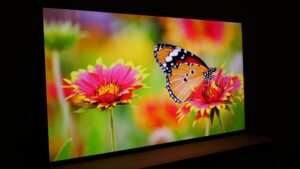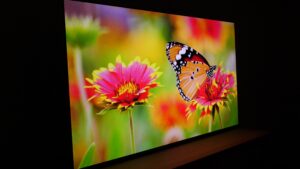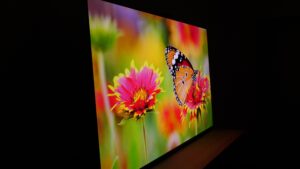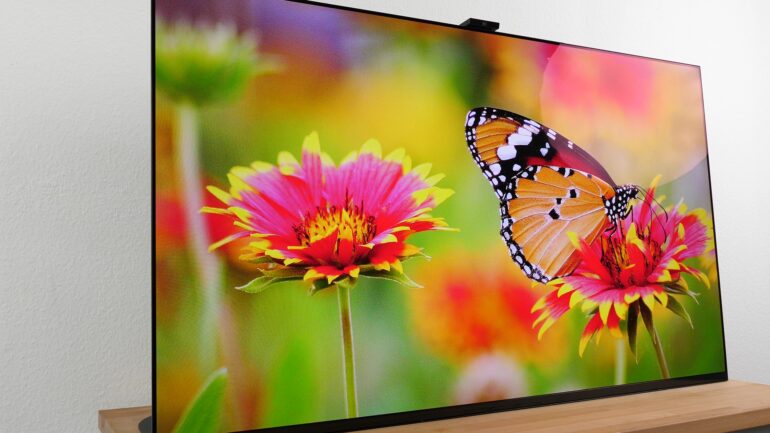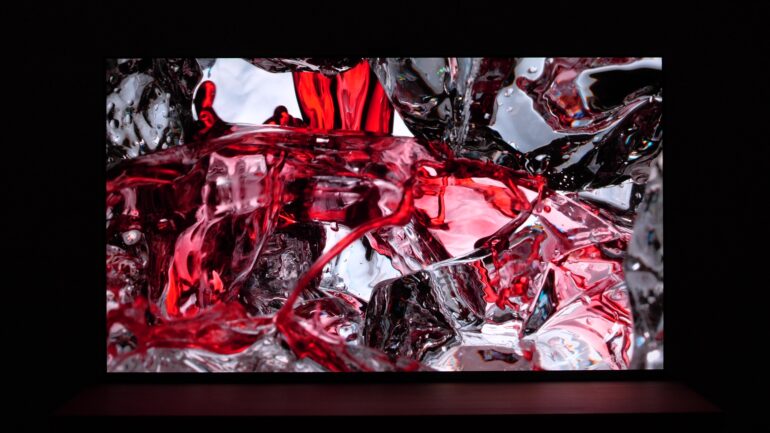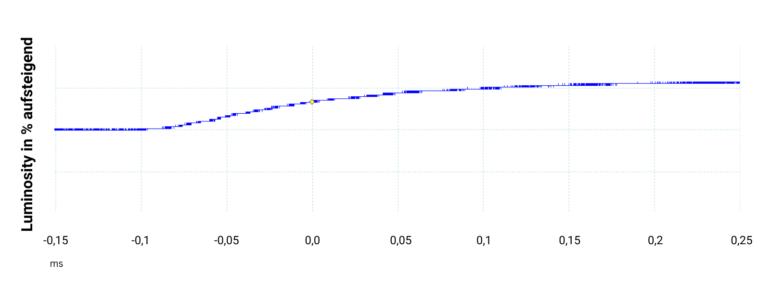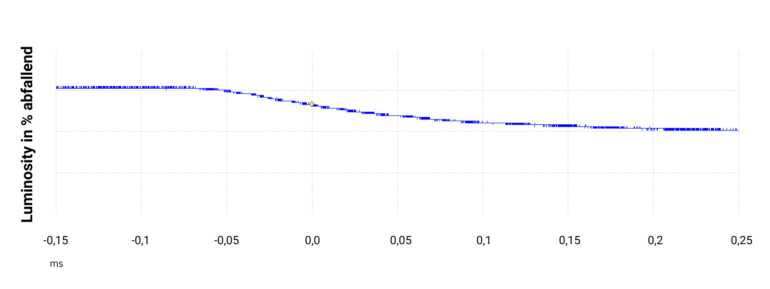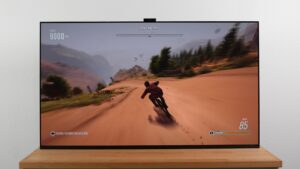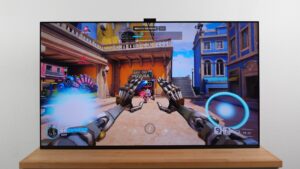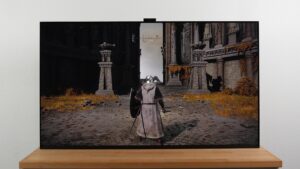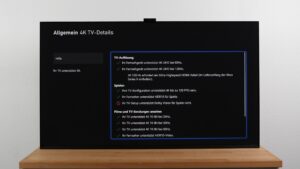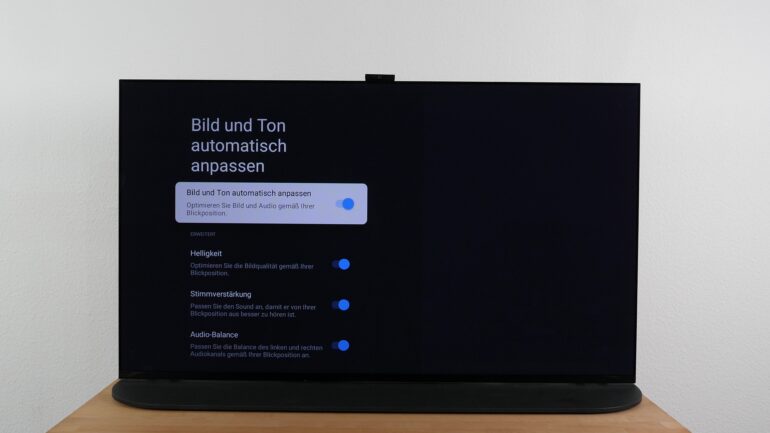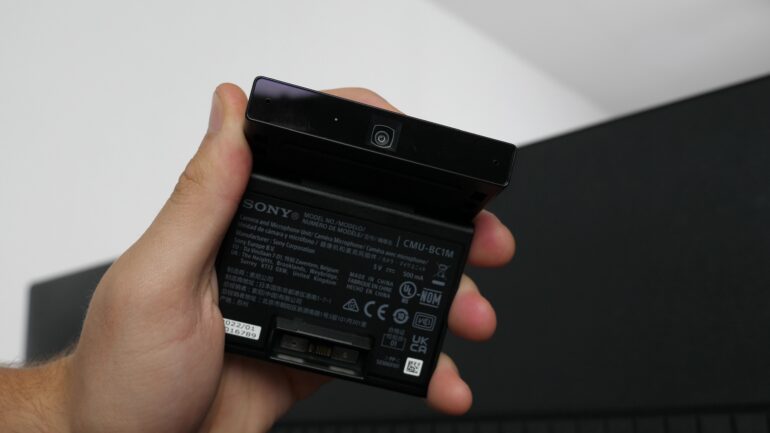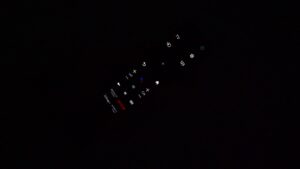Sony A95K Review & Rating

tvfindr Editorial
As a studied technology journalist Tobi likes to write regularly about the colorful world of TV sets & Co. Further interests: Music, cars, gaming, soccer
Sony A95K — The winner in terms of image performance
Sony does a lot of things right with their first QD OLED and prefers to focus on color fidelity instead of a few additional nitsSI unit of luminance: 1 nit = 1 cd/m2 – The best way of measuring and comparing a TVs brightness of peak brightness with the Sony A95K. Despite the identical panel, the high-end TV fails to reach the brightness level of the Samsung S95B, but is ahead in terms of tone mapping. Thus, picture quality remains the main attraction of Sony TVs and is a real selling point for customers.
Due to a special mounting method, the massive stand disappears completely behind the panel. The disadvantage: If you want to place a soundbar directly in front of it, you will cover the lower edge of the screen more or less, depending on the case size.
The additional Bravia Cam on the upper frame of the TV provides you with some interesting additional functions, such as automatic picture and sound adjustment or a distance function to determine the optimal viewing range. Gamers will also be able to enjoy current gaming features, but Dolby VisionDynamic HDR-format with a color depth of up to 12 Bits and Mastering of up to 10,000 Nits will only be available with up to 60 hertz on your Xbox Series X|S.
However, if we look at the price, we cannot avoid emphasizing that buyers have to reckon with a sharp surcharge of more than 1000 Euros for a 65-inch model compared to the direct competition. That is quite hefty.
- Displays colors great
- Deep black level
- Viewing angle stable
- Brightness at about 1000 nits
- Short input lag
- Additional features through included Bravia Cam
- Output of native Dolby Atmos and DTS:X via eARC
- Dolby Vision only up to 60 hertz
- Soundbar placement in front of the TV problematic
- Panel with pinkish color cast
- Significantly more expensive than the competition
Prices and Deals of Sony A95K *
| A95K Series | Differences from the main variant | 42" | 48" | 55" | 65" | 77" |
|---|---|---|---|---|---|---|
| A90K | 42A90K | 48A90K | ||||
| A75K | 55A75K | 65A75K | ||||
| A80K | 55A80K 1,598.00 €* | 65A80K | 77A80K 2,548.00 €* | |||
| A95K Variant tested here | 55A95K | 65A95K |
Possible alternative solutions for the Sony A95K
Of course, you cannot avoid the direct competitor from Samsung at this point. The S95B is not only brighter, but also considerably cheaper. However, the QD competitor does not offer Dolby VisionDynamic HDR-format with a color depth of up to 12 Bits and Mastering of up to 10,000 Nits at all.
LG’s OLED evo G2 with a particularly slim design, additional heat sink and comparable brightness is not a QD model, but still great. The Sony X95K with Mini LED technology is the cinema TV option for bright rooms.
More affordable QD alternative: Samsung S95B
OLED with additional heat sink: LG OLED evo G29
For brighter rooms: Sony X95K
The Sony A95K features a special stand design
Even before unpacking, it was noticeable that our 65-inch test device seems particularly heavy. With a packaging weight of over 50 kilograms, this also proved to be true afterwards.
Compared to the competition from LG and Samsung, the A95K actually weighs a few kilos more and is even heavier without a base than, for example, the S95B with its stand. Sony itself states a weight of 27 kilograms for the TV alone. In addition, the foundation is by no means light.
- Great processing
- Thin frame
- Stable stand
- Two mounting options
- Limited positioning of a soundbar
- Option for cable mounting is missing
We noticed that Sony has given the A95K a unique stand design, similar to the flagship OLED A90K, while neatly assembling the TV. In short: If you mount the stand in the intended way using the so-called “front position“, the stand disappears completely behind the panel and is no longer visible from the front.
Thus, the bottom edge can be flush with the surface and you only see the screen including the frame. However, you will notice that the A95K tilts backwards by a few degrees when you look at it from the side. This is probably due to the stability.
Downside: Positioning a soundbar in front of the screen restricts the view of the bottom edge – depending on the dimensions of your model – and could even become a problem when displaying subtitles.
Two set-up options: This is how the Sony A95K stands securely
If you don’t like the tilt, you can simply rotate the base by 180 degrees, place the TV on top of it and thus achieve a straight alignment of the panel. This option at least gives you a bit more room to move towards the lower edge of the screen.
On the back, we found a lot of plastic and a raster pattern. The ports can be covered conveniently and cables can be routed out accordingly. Otherwise, we could not determine any negative points in the build quality of our test device.
Both the case and the stand are quite ordinary, but they still make a solid impression. You will only really see the stand itself when you choose the optional mounting solution.
Sony A95K with QD panel by Samsung
Before we get to the display performance of the Sony A95K, a quick digression on the topic of OLED TVs: Panels of these specific models have a layer of self-luminous, organic pixels that can completely turn off when needed.
Therefore, all OLEDs without exception have basically a perfect black level. TVs with this technology thus have the advantage of an almost unlimited high contrast ratio and offer a picture quality on a high level right from the start.
- High color fidelity
- Deep OLED black
- Best viewing angle stability
- Clean display of unit areas
- 1000 nits brightness
- Reflections are clearly reduced
- Pink cast: In bright light, black can appear as purple
Of course, this looks a bit different in reality because the pixels cannot become arbitrarily bright due to temperature restrictions. The Sony A95K QD-OLED also has a special characteristic. The white subpixel of conventional OLED models is replaced by a self-luminous blue pixel layer.
In addition, so-called quantum dots are used to display the colors. Thus, the pixels can work more effectively and the panel is brighter overall. Technically, Sony is using technology provided by Samsung Display.
The usual OLED qualities can be seen on the Sony A95K.
Several additional advantages also go hand in hand with this. The local dimming of our test device behaves perfectly and does not show any halo effect. The same applies to the visualization of homogeneous color gradients over a larger surface. Nobody wants to have a so-called dirty screen. So, the gray uniformity also turns out correspondingly clean and has almost no darker areas or spot islands.
As expected, the viewing angle stability is also absolutely good and shows what OLEDs are capable of. The quality of the content remains remarkably constant even in a comparatively slanted view and literally invites you to long movie nights in large groups.
An S95B with the same panel can already counter reflections quite well. The A95K does not flinch for long either and deals with reflections quite rigorously considering it is an OLED. Bright light sources are effectively minimized.
However, if you would like to have really deep blacks, avoid placing the TV in a bright room or darken the screen when there is a lot of room brightness. Why? Otherwise, black areas in the picture take on a noticeably strong purple hue and lose some of their effect.
Reliable color representation
We have now dealt with most of the quality factors in terms of the image. But how does the actual HDR performance of the Sony QD-OLED compare to the competition? Of course, the comparison with the Samsung S95B is obvious here as well. The Sony displays HDRHigh Dynamic Range – image/video with more dynamic range (contrast range) content more accurately and with higher color quality. Highlights and details are rendered brightly.
The S95B has a better overall peak brightness, but then struggles with detail loss in dark image areas, also known as black crush. At this point, the A95K’s excellent tone mapping comes into play and helps content appear almost lifelike. In the picture quality category, the A95K is definitely on the top shelf and is one of the best TVs on the market.
Extremely responsive Sony A95K
Thanks to a nearly instantaneous response time of the 120 HertzHertz is the derived SI-unit of frequency with 1Hz=1/s – When talking about TVs this means how many different pictures a TV can display in one second. panel, image movements are executed immediately and smooth, shadow-free gradients can be achieved. Motion blur is not common. Anything else would have surprised us, to be honest.
So, if there is a lot of action on the screen or the ball flies into the opponent’s goal at over 100 kilometers per hour, you can follow the action more closely. Another option is the black frame insertion method.
- Pleasantly fast response time
- Panel with 120 frames per second
- Selectable interpolation against stutter
- Disturbing judder can be filtered out
- Black Frame Insertion reduces brightness immensely
- Soap Opera possible with intermediate image calculation turned on
However, we normally don’t recommend these functions. On one hand, the overall picture becomes noticeably darker, on the other, your eyes might notice a flickering. However, if the camera pans slowly through the picture, the advantage can quickly turn into a disadvantage, since unpleasant jerks can occur.
Although the activation of the interpolation helps at first, you might have to deal with the soap opera effect that looks unnatural for some viewers. When the JudderInconsistent time frame due to the input frequency not mismatching the TV’s frequency (e.g. 24p via 60Hz) function is enabled, stuttering is reliably removed. Ultimately, our own measurement of rise and fall times confirmed the screen’s good response and remains within Sony’s stated specifications.
Dolby Vision only possible with limitations on the Sony A95K
The Sony A95K is definitely a friend of the latest video game devices from Sony and Microsoft and therefore offers all the options you need to fully exploit the potential of your titles. However, there are some small features that you should pay attention to in order to avoid wasting time on the settings.
Yes, the A95K supports Dolby Vision gaming on the Xbox Series X. No, the advanced color space is not supported at a resolution of 4K and 120 hertz. A refresh rate of 60 frames per second is the limit. Yes, the model has an Auto Low Latency Mode that automatically handles various optimizations for gaming.
- 4K resolution with up to 120 frames per second
- Gaming mode for input optimization
- Low delay with about 9 ms
- Variable refresh rate against screen tearing
- HDMI 2.1 standard
- Dolby Vision gaming only possible at up to 60 hertz
- No cloud gaming apps
Unfortunately, this only happens on the Xbox if you activate the automatic picture mode in the settings first. On the PlayStation 5, however, you do not have to do anything. The input lag varies depending on the resolution, but is still within a pleasantly short range of 8.9 milliseconds at most.
Sony A95K - The expectedly flat sound
Like basically all TVs without a soundbar solution, the 2.2 speakers of the A95K with a total of 60 watts of continuous power hardly produce any bass worth mentioning. Thus, the sound image naturally suffers especially in low frequencies and makes you as a viewer feel much less immersed in the sound world of movies, series or a video game and therefore left rather unimpressed.
Ordinary TV broadcasts of course sound good on a device in this price range. In the end, however, you have to expect that the speakers cannot keep up with the high picture quality in terms of sound – assuming a certain usage behavior.
- 2.2 sound system with 60 watts of continuous power
- eARC with Dolby Atmos and DTS:X
- Clear speech reproduction
- Automatic sound configuration
- Acoustic Center Sync function
- Weak basses
If you think that turning up the volume will solve this problem, we will immediately steal your thunder. If the noise level gets too high, the QD-OLED finally reaches its limits and increasingly distorts. Then even normal speech reproduction does not sound nice anymore.
Our advice is once again simple: If you want a good sound experience, go for a soundbar or home theater set. Here, the Sony A95K offers you the supported Acoustic Center Sync function, for example. If you use a Sony soundbar, the center speaker of the TV will be supported additionally.
You can also enjoy uncompressed Dolby Atmos or DTSMulti-channel-sound-system (Surround Sound) competing with Dolby Digital:X sound via eARC. Are you still in doubt about your purchase decision or did you simply not find the right model? Feel free to take the way to our helpful buying guide on soundbarfindr.com.
Bravia Cam provides additional features for the Sony A95K
Besides the special feature of video calls, which you of course receive directly via the screen, Sony lists many additional benefits of its Bravia Cam that are provided by the small camera lens. First of all, there is the gesture control, which allows you to change the program or the volume without a remote control.
Voice functions are managed on the basis of Google Assistant or Alexa. A distance warning informs you if you are sitting too close to the screen and should move further away to get a better view.
- Bravia Cam
- Gesture control
- Voice control via Google Assistant and Alexa
- Automatic picture and sound adjustment
- Illuminated remote control
- Apple interfaces for AirPlay and Homekit
- Inefficient navigation around the operating system
Using person recognition, the TV knows exactly where you are located in the room and adjusts the picture and sound settings to this position. Dialogs are supposed to be heard more clearly and the brightness of the display is adjusted to the environment.
The operating system is based on Android 10 and is rather messy and not very intuitive in our opinion. Sony definitely wastes potential here. Nevertheless, you will find everything you need in terms of today’s important apps.
The remote control is illuminated, so you can still see where you are pressing even in the dark. Apple users can use Airplay and Homekit if needed. You will also find the usual functions like timeshift or recording via USB.
Sony A95K Datasheet
55A95K technical specifications
Dimensions
| Screen diagonal | 55 Inch |
|---|---|
| Dimensions without stand (WxHxD) | 1225 x 714 x 43 mm |
| Weight without stand | 21,2 kg |
| Dimensions with stand (WxHxD) | 1225 x 728 x 280 mm |
| Weight with stand | kg |
| Footprint (WxD) | 1222 x 280 mm |
| VESA Norm | 300 x 300 mm |
Image properties
| Panel type | QD-OLED Panel |
|---|---|
| Panel Manufacturer | LG Display |
| Colour depth | 10 Bit |
| FRC | |
| Resolution | 4K |
| Contrast ratio | infinitely :1 |
| Color space coverage | 94 % |
| REC 2020 | 51 % |
| Average brightness | 880 Nits |
| Maximum brightness | 1000 Nits |
| Backlighting | OLED |
| Local dimming | OLED |
| Dimming Zones | N/A |
| Curved | |
| Improved viewing angle |
Motion Handling
| Response Time | < 1 ms |
|---|---|
| Input Lag | < 17 ms |
| Frequency | 120 Hz |
| VRR |
HDR
| HDR | |
|---|---|
| HDR10 | |
| HLG | |
| HDR10+ | N/A |
| Dolby Vision |
Energy
| Energy consumption standby (W) | 0,5 W |
|---|---|
| Energy consumption SDR | 84 W |
| Energy efficiency clas SDR | G |
| Energy consumption HDR | 114 W |
| Energy efficiency clas HDR | G |
Smart TV
| Operating system | Google TV |
|---|---|
| Bluetooth | |
| WLAN | |
| USB recording PVR | |
| Timeshift | N/A |
| Picture-in-picture | N/A |
| Tuner | Analog (NTSC/PAL/SECAM) DVB-T DVB-T2 DVB-C DVB-S DVB-S2 |
| Twin Tuner |
Audio
| Audio Channels | 2.2 |
|---|---|
| Power (W) | 60 W |
| Dolby Digital | |
| DTS | |
| Dolby Atmos | |
| Integrated soundbar |
Connections
| HDMI 2.0 | 2 |
|---|---|
| HDMI 2.1 | 2 |
| HDMI ARC | |
| USB 2.0 | 1 |
| USB 3.0 | 1 |
| Ethernet RJ45 | 1 |
| 3.5mm jack | 1 |
| Digital optical | 1 |
| Satellite | 1 |
| Antenna | 1 |
| Ci+ 1.4 | 1 |
65A95K technical specifications
Dimensions
| Screen diagonal | 65 Inch |
|---|---|
| Dimensions without stand (WxHxD) | 1444 x 837 x 42,8 mm |
| Weight without stand | 27 kg |
| Dimensions with stand (WxHxD) | 1444 x 851 x 301 mm |
| Weight with stand | kg |
| Footprint (WxD) | 1441 x 301 mm |
| VESA Norm | 300 x 300 mm |
Image properties
| Panel type | QD-OLED Panel |
|---|---|
| Panel Manufacturer | LG Display |
| Colour depth | 10 Bit |
| FRC | |
| Resolution | 4K |
| Contrast ratio | infinitely :1 |
| Color space coverage | 94 % |
| REC 2020 | 51 % |
| Average brightness | 880 Nits |
| Maximum brightness | 1000 Nits |
| Backlighting | OLED |
| Local dimming | OLED |
| Dimming Zones | N/A |
| Curved | |
| Improved viewing angle |
Motion Handling
| Response Time | < 1 ms |
|---|---|
| Input Lag | < 17 ms |
| Frequency | 120 Hz |
| VRR |
HDR
| HDR | |
|---|---|
| HDR10 | |
| HLG | |
| HDR10+ | N/A |
| Dolby Vision |
Energy
| Energy consumption standby (W) | 0,5 W |
|---|---|
| Energy consumption SDR | 113 W |
| Energy efficiency clas SDR | F |
| Energy consumption HDR | 137 W |
| Energy efficiency clas HDR | G |
Smart TV
| Operating system | Google TV |
|---|---|
| Bluetooth | |
| WLAN | |
| USB recording PVR | |
| Timeshift | N/A |
| Picture-in-picture | N/A |
| Tuner | Analog (NTSC/PAL/SECAM) DVB-T DVB-T2 DVB-C DVB-S DVB-S2 |
| Twin Tuner |
Audio
| Audio Channels | 2.2 |
|---|---|
| Power (W) | 60 W |
| Dolby Digital | |
| DTS | |
| Dolby Atmos | |
| Integrated soundbar |
Connections
| HDMI 2.0 | 2 |
|---|---|
| HDMI 2.1 | 2 |
| HDMI ARC | |
| USB 2.0 | 1 |
| USB 3.0 | 1 |
| Ethernet RJ45 | 1 |
| 3.5mm jack | 1 |
| Digital optical | 1 |
| Satellite | 1 |
| Antenna | 1 |
| Ci+ 1.4 | 1 |
Frequently asked questions about the Sony A95K
What is the difference between QD-OLED and OLED?
Which TVs still use QD-OLED?
Since the QD-OLED approach is still in its first generation and thus practically new on the TV market, only the Samsung S95B uses this technology besides the Sony A95K.
How bright does a QD-OLED get?
Do QD-OLEDs have a high burn-in risk?
Sony A95K Connections
The 65A95K has 2 HDMI 2.1 inputs and 2 HDMI 2.0 inputs, an HDMI eARC, one USB 3.0 port, one USB 2.0 port, a 3.5mm headphone jack, a digital optical TOSLINK output and a Twin Tuner. and just a Single Tuner.
Sony A95K Dimensions
The Sony A95K is dimensioned without stand as follows (WxHxD):
- 55 Inch: 1225 x 714 x 43 mm
- 65 Inch: 1444 x 837 x 42,8 mm
Sony A95K Wall Mounting
The Sony A95K is compatible with the following wall mounts:
- 55 Inch: 300 x 300 mm
- 65 Inch: 300 x 300 mm
